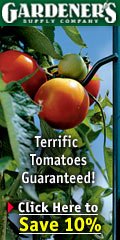Home
 Reading Room
Reading Room
 Miscellaneous
Miscellaneous
 Seed Saving
Seed Saving
Save and Exchange Seeds
to Preserve Genetic Diversity
by Stacy LaVres
Today, agriculture uses only 20 plant varieties for 90 percent of our food, although
there are an estimated 30,000 to 80,000 food plants in existence. Ninety-seven percent of
the food plants our grandparents ate at the turn of the century are no longer available.
Farmers and gardeners regularly saved their own seeds until the last 40 years, when
business interests aggressively campaigned for hybrids. Since hybrids will not breed true
– meaning the seed will either be sterile or unlike the parent plant – the
grower must purchase seed every season. Hybrids themselves are not the problem. In fact,
they may be used selectively as part of a diversified system. However, hybrid seed is more
profitable for companies than open-pollinated seed, and as a result, countless varieties
are being lost.
There is no doubt that hybrids have significantly increased production, so why would
anyone want to return to open-pollinated varieties? One reason is that they are
genetically diverse, while hybrids are genetically identical. This difference can be
crucial when diseases or pests strike. When all plants in an area are genetically the
same, what destroys one will destroy the entire population. Genetic diversity improves the
chances that some will live.
Hybrids are bred for certain traits that are usually not important to the home gardener
– for example, tough flesh for transporting, ease of mechanical harvesting, and
ripening within a short time period. Also, certain breeding programs are choosing strains
that will only grow well with pesticides and petrochemical fertilizers.
Sustainable growing needs to encompass the entire cycle, from soil to seed to plant to
seed and back to soil. As you save seed from several generations, you will be selecting
from plants that grew vigorously, suffered less from pests, and survived the drought. The
seeds you buy cannot suit your site as well as the ones you keep.
When searching for seed, first check your neighbourhood. You may find plants that are
suited to your garden, and sharing and trading seeds with local people can build strong
community conweather, frost resistance, vigour, performance, appearance, lack of
complicaton, day length, days to maturity, time of harvest, ease of harvest, storage, ease
of cleaning, ease of preparation, eating quality, nutrition and marketability. You may
also consider species that attract beneficial insects.
Make sure to take notes throughout the season. Record keeping will greatly add to your
understanding of your garden, preserve valuable information for future growers, and
ultimately, save time and stress as you pick plants that require less maintenance and
inputs.
Seeds are more than just genetic carriers. Heirloom and open-pollinated varieties
reflect years of nurturing and commitment by seed savers from an array of cultures.
Passing these tiny storehouses on to the next generation is one of the most valuable gifts
each of us can give. Without our help, this beautiful, diverse heritage could be
irrevocably lost. Here is to seeds, here is to life!
Recommended Reading:
Seeds of Change – the Living Treasure by K. Ausubel (1994, Harper Collins)
The New Organic Grower: A Master's Manual of Tools and Techniques for the Home and
Market Gardener by E. Coleman (1989, Chelsea Green)
Seed to Seed by S. Ashworth (1991, Seed Saver Publications)
The Heirloom Gardener by C. Jabs (1984, Sierra Club Books)
Saving Seeds by M. Rogers (1994, Storey/Garden Way Publishing
This article was supplied by the
Kerr Center for Sustainable Agriculture,
Box 588, Poteau OK 74953 USA. The Kerr Center
publishes a free bimonthly newsletter and provides assistance to farmers who
seek ecological and economical methods of growing.
|





